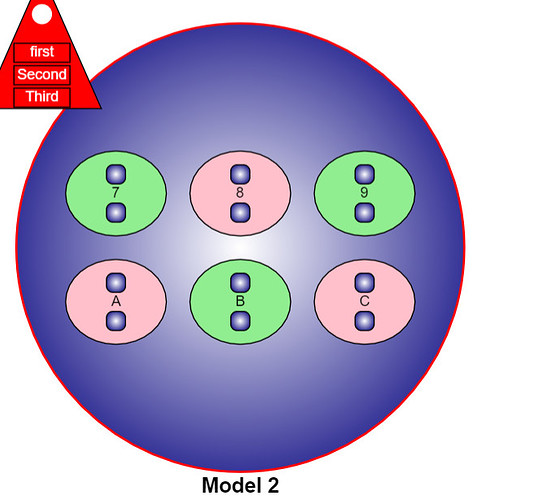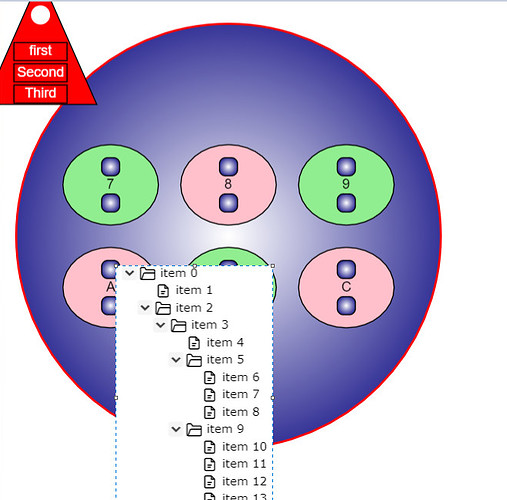It turns out that the Local View sample is similar to what you want to do:
Except that you want to show the diagram with the local view in a tooltip instead of in a separate HTMLDivElement as is normally the case. So I started with a copy of that sample, stripped out unneeded code, and added a tooltip to the node template.
<!DOCTYPE html>
<html>
<head>
<title>Local View</title>
<!-- Copyright 1998-2020 by Northwoods Software Corporation. -->
<meta name="description" content="In one diagram show the whole tree and in a second diagram show a subset that is logically near a selected node." />
<meta name="viewport" content="width=device-width, initial-scale=1">
<script src="go.js"></script>
<script id="code">
function init() {
var $ = go.GraphObject.make; // for conciseness in defining templates
myFullDiagram =
$(go.Diagram, "fullDiagram", // each diagram refers to its DIV HTML element by id
{
initialDocumentSpot: go.Spot.Center,
layout: $(go.TreeLayout,
{ angle: 90, sorting: go.TreeLayout.SortingAscending })
});
myFullDiagram.nodeTemplate =
$(go.Node, "Auto",
{ locationSpot: go.Spot.Center },
new go.Binding("text", "key", go.Binding.toString), // for sorting
$(go.Shape, "Rectangle",
new go.Binding("fill", "color"),
{ stroke: null }),
$(go.TextBlock,
{ margin: 5 },
new go.Binding("text", "key", function(k) { return "node" + k; })),
{
toolTip:
$("ToolTip",
$(go.Panel, "Viewbox", { maxSize: new go.Size(200, 200) },
$(go.Picture, { name: "PIC", scale: 0.5 },
new go.Binding("element", "adornedPart", setupLocalView).ofObject())
)
)
}
);
myFullDiagram.linkTemplate =
$(go.Link,
{ routing: go.Link.Normal, selectable: false },
$(go.Shape,
{ strokeWidth: 1 })
);
myLocalDiagram =
$(go.Diagram, "localDiagram",
{
linkTemplate: myFullDiagram.linkTemplate, // same template as myFullDiagram
layout: $(go.TreeLayout,
{ angle: 90, sorting: go.TreeLayout.SortingAscending }),
"animationManager.isEnabled": false
});
myLocalDiagram.nodeTemplate =
$(go.Node, "Auto",
{ locationSpot: go.Spot.Center },
new go.Binding("text", "key", go.Binding.toString), // for sorting
$(go.Shape, "Rectangle",
new go.Binding("fill", "color"),
{ stroke: null }),
$(go.TextBlock,
{ margin: 5 },
new go.Binding("text", "key", function(k) { return "node" + k; }))
);
// Create the full tree diagram
setupDiagram();
}
function render(e) {
myLocalDiagram.removeDiagramListener("InitialLayoutCompleted", render);
var tt = myFullDiagram.toolManager.currentToolTip;
if (tt !== null && tt.adornedPart.key === myLocalDiagram.selection.first().key) {
tt.findObject("PIC").element = myLocalDiagram.makeImage({ scale: 2, showTemporary: true });
}
}
function setupLocalView(node) {
// create a new model for the local Diagram
var model = new go.TreeModel();
// add the selected node and its children and grandchildren to the local diagram
var nearby = node.findTreeParts(3); // three levels of the (sub)tree
// add parent and grandparent
var parent = node.findTreeParentNode();
if (parent !== null) {
nearby.add(parent);
var grandparent = parent.findTreeParentNode();
if (grandparent !== null) {
nearby.add(grandparent);
}
}
// create the model using the same node data as in myFullDiagram's model
nearby.each(function(n) {
if (n instanceof go.Node) model.addNodeData(n.data);
});
myLocalDiagram.addDiagramListener("InitialLayoutCompleted", render);
myLocalDiagram.model = model;
// select the node at the diagram's focus
var selectedLocal = myLocalDiagram.findPartForKey(node.key);
if (selectedLocal !== null) selectedLocal.isSelected = true;
return null;
}
// Create the tree model containing TOTAL nodes, with each node having a variable number of children
function setupDiagram(total) {
if (total === undefined) total = 100; // default to 100 nodes
var nodeDataArray = [];
for (var i = 0; i < total; i++) {
nodeDataArray.push({
key: nodeDataArray.length,
color: go.Brush.randomColor()
});
}
var j = 0;
for (var i = 1; i < total; i++) {
var data = nodeDataArray[i];
data.parent = j;
if (Math.random() < 0.3) j++; // this controls the likelihood that there are enough children
}
myFullDiagram.model = new go.TreeModel(nodeDataArray);
}
</script>
</head>
<body onload="init()">
<div id="sample">
<div id="fullDiagram" style="height:550px;width:100%;border:1px solid black;margin:2px"></div>
<div id="localDiagram" style="display:none"></div>
<button onclick="setupDiagram()">Create New Tree</button>
</div>
</body>
</html>

